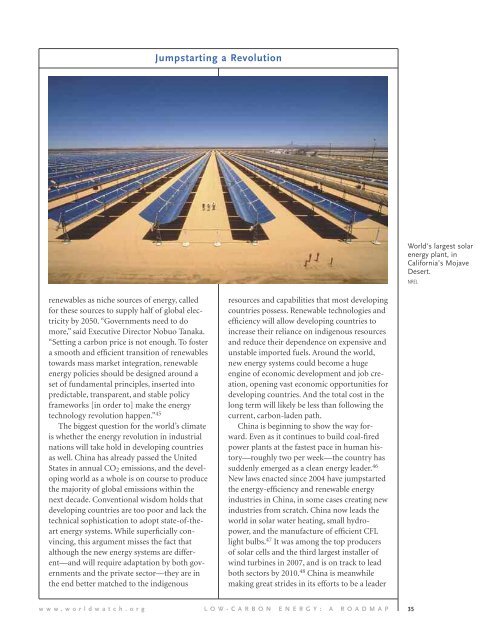Worldwatch Institute
Worldwatch Institute
Worldwatch Institute
You also want an ePaper? Increase the reach of your titles
YUMPU automatically turns print PDFs into web optimized ePapers that Google loves.
Jumpstarting a Revolution<br />
World's largest solar<br />
energy plant, in<br />
California’s Mojave<br />
Desert.<br />
NREL<br />
renewables as niche sources of energy, called<br />
for these sources to supply half of global electricity<br />
by 2050. “Governments need to do<br />
more,” said Executive Director Nobuo Tanaka.<br />
“Setting a carbon price is not enough. To foster<br />
a smooth and efficient transition of renewables<br />
towards mass market integration, renewable<br />
energy policies should be designed around a<br />
set of fundamental principles, inserted into<br />
predictable, transparent, and stable policy<br />
frameworks [in order to] make the energy<br />
technology revolution happen.” 45<br />
The biggest question for the world’s climate<br />
is whether the energy revolution in industrial<br />
nations will take hold in developing countries<br />
as well. China has already passed the United<br />
States in annual CO 2 emissions, and the developing<br />
world as a whole is on course to produce<br />
the majority of global emissions within the<br />
next decade. Conventional wisdom holds that<br />
developing countries are too poor and lack the<br />
technical sophistication to adopt state-of-theart<br />
energy systems. While superficially convincing,<br />
this argument misses the fact that<br />
although the new energy systems are different—and<br />
will require adaptation by both governments<br />
and the private sector—they are in<br />
the end better matched to the indigenous<br />
resources and capabilities that most developing<br />
countries possess. Renewable technologies and<br />
efficiency will allow developing countries to<br />
increase their reliance on indigenous resources<br />
and reduce their dependence on expensive and<br />
unstable imported fuels. Around the world,<br />
new energy systems could become a huge<br />
engine of economic development and job creation,<br />
opening vast economic opportunities for<br />
developing countries. And the total cost in the<br />
long term will likely be less than following the<br />
current, carbon-laden path.<br />
China is beginning to show the way forward.<br />
Even as it continues to build coal-fired<br />
power plants at the fastest pace in human history—roughly<br />
two per week—the country has<br />
suddenly emerged as a clean energy leader. 46<br />
New laws enacted since 2004 have jumpstarted<br />
the energy-efficiency and renewable energy<br />
industries in China, in some cases creating new<br />
industries from scratch. China now leads the<br />
world in solar water heating, small hydropower,<br />
and the manufacture of efficient CFL<br />
light bulbs. 47 It was among the top producers<br />
of solar cells and the third largest installer of<br />
wind turbines in 2007, and is on track to lead<br />
both sectors by 2010. 48 China is meanwhile<br />
making great strides in its efforts to be a leader<br />
w w w . w o r l d w a t c h . o r g L O W - C A R B O N E N E R G Y : A R O A D M A P 35









